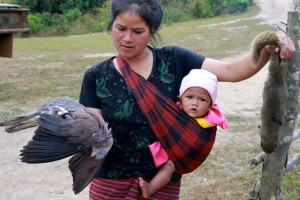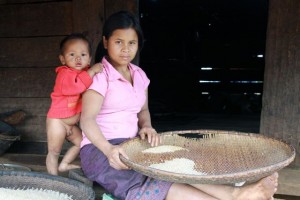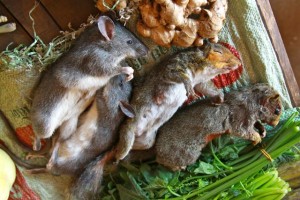Project Sekong 2012: Our village has little surplus food, therefore there’s no food market. Villagers forage and hunt on our behalf.

Without refrigeration its difficult for us to keep fish or meat on hand. Luckily, village women forage for food to sell us and men hunt game. Not every find or catch is what we prefer but usually the offerings are a good supplement to foods available in the Dak Cheung market.
Report 34
We’re overdue for another food run to Dak Cheung, twenty miles east of here, the closest village that has a food market. Making the slow, round-trip over terrible roads always costs us a half-day of productivity so we don’t make the trip until we’re badly in need of either food or fuel. While we’re not yet desperate, the quality of our meals is unquestionably heading south and we can’t put off shopping much longer.
Our food situation is always feast or famine. For a couple of days after shopping we eat like kings but, since we lack any way to refrigerate food, our provisions age quickly, spoilage strikes and soon we’re down to rice and little else.
Ben Franklin observed that fish and company both smell after two days. In this heat, fish lose their charm faster than that. We grill fish the first day it comes home, boil it the next. By day three it’s usually too far gone to eat so we feed what remains to the dogs.
Fish gone, we start in on the red meat that we’ve purchased: pork or beef, or water buffalo. At first we grill or fry the meat. A day or two later, we add the aging cuts to stews and cook the hell out of it. When we judge that a hunk of raw meat is nearing the end of life, we slice it into thin strips and smoke them until they are as dry as a leather belt. (Our homemade jerky is great when dipped in a Lao salsa made from chilies, onions, garlic and tomatoes that have all been charred over glowing embers and then pounded into a mash).

The Lao consider any meal--- breakfast, lunch, or dinner, incomplete without rice. We're able to purchase both steam rice and sticky rice from local villagers. That's lucky for us because among our multi-ethnic team there are definite preferences.
We’ve never run short of rice; it’s proved to be the easiest staple to find and we have a supply of both steam rice and sticky rice to see us through the end of this project. The Khmer and Hmong guys prefer steam rice; the Lao and Laven vote for sticky. I’m a switch hitter and will go with whichever is available when the rest of my meal comes together.
Vegetables are hard to find, expensive to buy, and difficult to keep. The market in Dak Chueng rarely has beans, peas, broccoli or other greens. Cabbage, cabbage and more cabbage fill the gap. While tomatoes are abundant potatoes are precious gems.
This morning a young lady stopped by camp with a wild hen and a squirrel that her husband caught in snares, and an elderly woman showed up with five small fish from her family pond as well as two large hands of bananas and a plastic bag filled with a variety of greens, some from her garden and some from the forest. So… dinner tonight should be much better than today’s breakfast and lunch.
We appreciate the women who forage and the men who hunt on our behalf but often we don’t have knowledge of all the plants that we’re offered and sometimes the wild game is a mite too gamey. We’ve turned down snake, rat, and dog.
I’ve still got a stash of falang food that I’m hoarding against desperate times. There’s a can of Hunt’s tomato sauce, two small onions, a bulb of garlic and several egg plant that I’ll turn into a meal that I’ll pass off to the team as Italian food (so America doesn’t take the blame for my poor cooking skills).
Two nights ago I served the team “Mexican.” I added grilled onions and minced garlic to a can of re-fried beans, then stirred in a healthy dollop of Lao salsa, and brought the mixture to a boil. Lacking taco shells, I convinced everyone to wrap the bean mixture in cabbage leaves. (If there’s one thing we have in abundance, it’s cabbage!)

It's a long drive for us to reach the nearest market and even then the choices are very limited. Luckily villagers hunt and trap small game for us.
The villagers here are discerning about which rats they’ll eat. They trap rats living in the wild and cook them up much as they do squirrel. On the other hand, villagers won’t eat rats caught around the house. I agree with the distinction they make: rats in the wild live a cleaner, healthier life and therefore make for a more wholesome meal. (With tail removed and fur burnt off in the coals of a fire, its mighty hard to tell a good-sized rat from a small squirrel). Don’t you agree?
